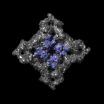(Press-News.org) Menlo Park, Calif.—Calcium regulates many critical processes within the body, including muscle contraction, the heartbeat, and the release of hormones. But too much calcium can be a bad thing. In excess, it can lead to a host of diseases, such as severe muscle weakness, a fatal reaction to anesthesia or sudden cardiac death.
Now, using intense X-rays from the Stanford Synchrotron Radiation Lightsource (SSRL) at the Department of Energy's SLAC National Accelerator Laboratory, researchers have determined the detailed structure of a key part of the ryanodine receptor, a protein associated with calcium-related disease. Their results, which combine data from SSRL and the Canadian Light Source, pinpoint the locations of more than 50 mutations that cluster in disease "hotspots" along the receptor.
"Until now, no one could tell where these disease mutations were located or what they were doing," said principal investigator Filip Van Petegem of the University of British Columbia in Vancouver.
The ryanodine receptor controls the release of calcium ions from a storehouse within skeletal-muscle and heart-muscle cells as needed to perform critical functions. Previous studies at lower resolution indicated that mutations cluster in three regions along the receptor, but without more detailed information it remained unclear exactly how they contributed to disease.
In a study published this week in Nature, Van Petegem and his group describe the structure of one of these hotspots in extremely fine detail and predict how the mutations might cause the receptor to malfunction and release calcium too soon.
The receptor is made up of more than 20,000 molecules called amino acids. Van Petegem's group studied a string of about 560 amino acids, where they found 57 mutations. In 56 cases, the mutations involved a change in a single amino acid, while the last one involved a deletion of 35 amino acids from the string.
"These mutations most likely cause the same disease effects, but a severe mutation leads to stronger symptoms, and doesn't require as big of a stimulus to induce disease," Van Petegem said.
In the heart, the receptor is stimulated to open about once a second when the body is at rest, sending regular pulses of calcium into the rest of the cell. In skeletal muscles, the timing of the pulses is determined by how often the muscles contract. Each time the receptor opens, certain amino acids rearrange themselves to facilitate the calcium release. Mutations can disrupt this process by causing the receptor to open either earlier or more easily than it should.
This premature release of calcium produces extra electrical signals within the cells. In skeletal muscle, this can lead to fatal rises in body temperature under certain anesthetics, or the failure of major muscles. In cardiac muscle it can trigger an arrhythmia, resulting in sudden cardiac death. While it is difficult to determine the exact number of people with these mutations, it is estimated that as many as one in 10,000 may be at risk for disease.
"Thanks to the technological capabilities at SSRL, we were able to rapidly screen hundreds of crystallized samples of this receptor protein to find ones with the best quality, giving the best structure. This study is a good first step toward designing new molecules that could be used as a drug," Van Petegem said. "These mutations could be a very promising therapeutic target for treating heart disease."
Future studies at SSRL and other synchrotron facilities will map out other receptor hotspots where these disease mutations cluster and use the detailed information to better understand the complex functions of the protein.
"It is very exciting to see the significant impact of our advanced structural biology technologies in helping users address difficult projects," said SSRL staff scientist Michael Soltis.
INFORMATION:
This research was supported by the Canadian Institutes of Health Research. The Stanford Synchrotron Radiation Lightsource is supported by the U. S. Department of Energy Office of Science. SLAC National Accelerator Laboratory is a multi-program laboratory exploring frontier questions in photon science, astrophysics, particle physics and accelerator research. Located in Menlo Park, California, SLAC is operated by Stanford University for the U.S. Department of Energy Office of Science.
The Canadian Light Source is Canada's national center for synchrotron research. Located at the University of Saskatchewan in Saskatoon, the CLS is a powerful tool for academic and industrial research in a wide variety of areas including environmental science, natural resources and energy, health and life sciences, and information and communications technology. CLS operations are funded by the Government of Canada, Natural Science and Engineering Research Council, National Research Council of Canada, Canadian Institutes of Health Research, the Government of Saskatchewan and the University of Saskatchewan.
X-rays offer first detailed look at hotspots for calcium-related disease
2010-11-05
ELSE PRESS RELEASES FROM THIS DATE:
Colonic navigation
2010-11-05
Nanoparticles could help smuggle drugs into the gut, according to a study published this month in the International Journal of Nanotechnology.
There are several drugs that would have more beneficial therapeutic effects if they could be targeted at absorption by the lower intestine. However, in order to target the colon for treating colon cancer for instance, medication delivered by mouth must surmount several barriers including stomach acidity, binding to mucus layers, rapid clearance from the gut, and premature uptake by cells higher up the gastrointestinal tract. Being ...
Helical CT scans reduce lung cancer mortality by 20 percent compared to chest X-rays
2010-11-05
PROVIDENCE, R.I. [Brown University] — In a major new study announced today by the National Cancer Institute, researchers including Brown University biostatistian Constantine Gatsonis and his colleagues found that screening for lung cancer using helical CT scanning reduced lung cancer deaths by 20 percent compared to using chest X-rays.
"The findings we're announcing today offer the first definitive evidence for the effectiveness of helical CT screening smokers for lung cancer " said Gatsonis, a lead biostatistician in the study and director of the American College of ...
Motor Neurone Disease Association study identifies MND biomarker
2010-11-05
A study funded by the Motor Neurone Disease (MND) Association, in collaboration with the Medical Research Council (MRC), has identified a common signature of nerve damage in the brains of MND patients.
The study's exciting findings have been published in the prestigious journal Neurology (2 November 2010). These are the first results to be published from the ongoing Oxford Study for Biomarkers in MND/ALS (BioMOx).
MND research is being held back by the lack of an early diagnostic test and predictable markers of the progression of the disease – biomarkers. Patients ...
The mind uses syntax to interpret actions
2010-11-05
Most people are familiar with the concept that sentences have syntax. A verb, a subject, and an object come together in predictable patterns. But actions have syntax, too; when we watch someone else do something, we assemble their actions to mean something, according to a new study published in Psychological Science, a journal of the Association for Psychological Science.
"There are oceans and oceans of work on how we understand languages and how we interpret the things other people say," says Matthew Botvinick of Princeton University, who cowrote the paper with his ...
AGU Journal highlights -- Nov. 4, 2010
2010-11-05
The following highlights summarize research papers that have been recently published in Geophysical Research Letters (GRL), Journal of Geophysical Research - Atmospheres (JGR-D), and Journal of Geophysical Research - Earth Surface (JGR-F).
1. Exploring climate patterns linking stratosphere, lower atmosphere
Roughly every 28 months, the zonal winds in the stratosphere at the equator cycle from easterly to westerly and then back to easterly. Known to atmospheric scientists as the quasi-biennial oscillation (QBO), these shifting wind patterns result when the energy from ...
Discovery shows promise against severe side effects
2010-11-05
November 4, 2010 – (BRONX, NY) -- A team of scientists has found a way to eliminate a debilitating side effect associated with one of the main chemotherapy drugs used for treating colon cancer. The strategy used in their preclinical research—inhibiting an enzyme in bacteria of the digestive tract—could allow patients to receive higher and more effective doses of the drug, known as CPT-11 or Irinotecan.
The study, spearheaded by scientists at the University of North Carolina at Chapel Hill and involving collaborators at Albert Einstein College of Medicine of Yeshiva University ...
Volcanic eruptions affect rainfall over Asian monsoon region
2010-11-05
Scientists have long known that large volcanic explosions can affect the weather by spewing particles that block solar energy and cool the air.
Some suspect that extended "volcanic winters" from gigantic eruptions helped kill off dinosaurs and Neanderthals.
In the summer following Indonesia's 1815 Tambora eruption, frost wrecked crops as far away as New England, and the 1991 blowout of the Philippines' Mount Pinatubo lowered average global temperatures by 0.7 degrees F--enough to mask the effects of greenhouse gases for a year or so.
Now, in research funded by the ...
UC doctoral student presents research at international conference
2010-11-05
Clement Loo, a University of Cincinnati doctoral student in the philosophy program, was one of the featured researchers at the biennial meeting of the Philosophy of Science Association Nov. 4-6 in Montreal, Quebec. The association promotes research, teaching and free discussion of issues in the philosophy of science.
Loo presented research themed around a Nov. 4 session on biology, evolution and selection. His paper was titled, "Invasive Species and Evaluating the Relative Significance of the Shifting Balance Theory."
The paper focused on the R.A. Fisher and Sewall ...
National Science Foundation launches "Innovation Nation"
2010-11-05
The National Science Foundation (NSF) today released the first in a series of video programs called Innovation Nation, hosted by veteran science and technology correspondent Miles O'Brien and currently airing nationally on the the Science Channel.
Innovation Nation is a quick look at what happens when genius meets possibility: stories about some of the NSF-funded inventions and research shaping our world.
The 26-part video series is produced by CBS News Productions, in partnership with the National Science Foundation and Discovery Science. Each episode is one minute ...
Food-allergy fears drive overly restrictive diets
2010-11-05
Many children, especially those with eczema, are unnecessarily avoiding foods based on incomplete information about potential food-allergies, according to researchers at National Jewish Health. The food avoidance poses a nutritional risk for these children, and is often based primarily on data from blood tests known as serum immunoassays.
Many factors, including patient and family history, physical examination, and blood and skin tests, should be used when evaluating potential food allergies. The oral food challenge, in which patients consume the suspected allergenic food, ...

